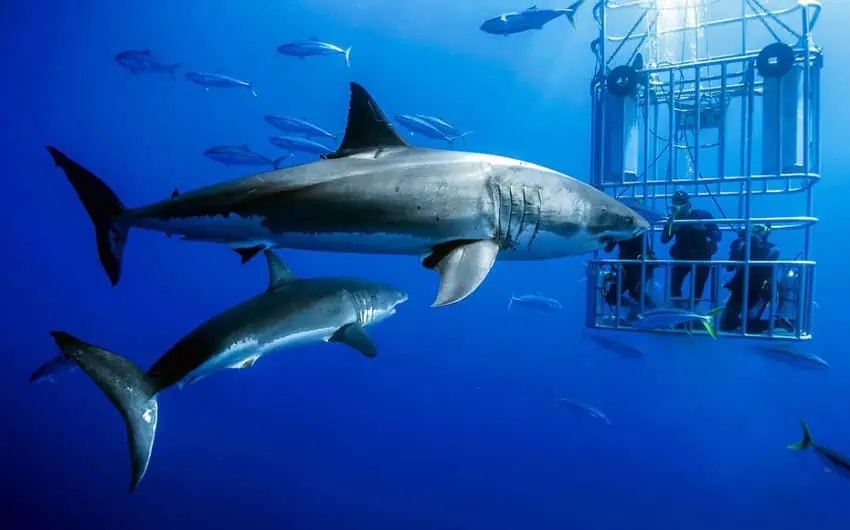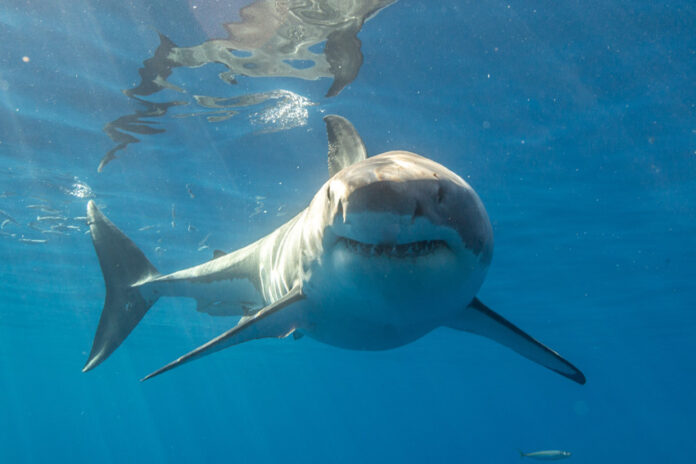It’s June 1975. Audiences are packing into cinemas to watch a young female character named Chrissie Watkins wander down to the ocean for a midnight swim. The setting is peaceful and beautiful, yet the flat sea and summer night sky carry a chilling edge of danger.
The shark attack, when it happens, is subtly filmed: There is no blood, no close-up of mutilated limbs. We hear muffled screams and see the woman being pulled underwater. Her drunken friend wakes on the beach in the morning to find her missing, and movies will never be the same again.
When Steven Spielberg’s “Jaws” was first released in 1975, it dramatically increased the public’s fear of sharks.
“Jaws,” when it was released 50 years ago, propelled Steven Spielberg to fame and marked the start of the summer blockbuster. From this point onwards, studios would be on the lookout for the next cultural phenomenon, a motion picture with a big budget and a star-studded cast that would bring in the crowds during the summer holiday season. “Star Wars,” “Alien,” ”Indiana Jones” and “Ghostbusters” all followed the path established by “Jaws.”
If “Jaws” revived the movie industry, it probably did little for scuba tourism. Despite widespread societal fear of them, shark attacks are extremely rare. Incidents can be classified into two types.
The first is the phenomenon of unprovoked bites, in which an attack occurs in the shark’s natural habitat with no human provocation. Swimmers, waders and surfers are the most common targets.
The second, a provoked bite, takes place when there a human interacts with a shark. This might include spearfishers, people attempting to feed or touch sharks or those trying to remove a captured shark from nets.
While most sharks can bite if provoked, three species account for the vast majority of unprovoked attacks: the bull shark, the tiger shark and, of course, the great white.
In 2024, there were 47 shark attacks reported around the world, with four fatalities. To put that into perspective, around 81,410 to 137,880 people die each year from snake bites, while 24,000 die from lightning strikes.

Mexico has a long coastline, and sharks can be found in both the Pacific and Atlantic oceans. However, no attacks were recorded in Mexico during 2024, and the last five years have seen just eight recorded attacks. Surprisingly, four of these were fatal, a high ratio of deaths to attacks that might suggest fishermen who receive some relatively minor injury do not report the bites.
Humans are far more deadly to sharks than sharks are to humans. According to a low estimate, 73 million sharks are taken from the seas every year, and the last decade has seen Mexico increase its share of this international trade. According to the National Aquaculture and Fishing Commission’s (Conapesca) Fisheries Statistical Yearbook, Mexico is now ranked sixth in terms of the total catch of sharks, with an annual catch of 20,000 to 40,000 tons per year.
A fisherman in Mexico receives around US $2 per kilogram of shark, but by the time the dried fins reach Asia, they can be worth up to $70. This market has resulted in several shark species in the Gulf of Mexico and the Caribbean being fished to the point where they are now described as being “exploited to the maximum sustainability.”
While the shark trade is regulated in Mexico, there are ways around any rule. Some fishing boats operate without permits or boats might creep out during the closed season, and protected species are still being caught. Add this to poor recordkeeping and corruption, and it is reasonable to assume that at least some of the shark that passes from Mexico to Asian markets is off the books.
While the situation in Mexico is uncertain, studies have shown that more than 70% of the fins that end up in Hong Kong fish markets come from vulnerable or endangered species. There is also a terrible level of animal cruelty in shark fishing. It is primarily a shark’s fin that is valuable, so it has become a common practice for fishermen to cut these from a living shark and then throw the animal back into the water, where the sharks, unable to swim, will slowly drown.
One hope for sharks is that humans are fascinated by them; each year, world shark tourism generates more than US $300 million. While any diver going into warm water might be lucky enough to spot these wonderful animals, there are a handful of Mexican dive sites famous for shark spotting. Playa del Carmen offers a variety of diving tours that focus on viewing the bull sharks that gather here from November to March.
Bull sharks are large sharks responsible for many attacks on humans. However, this is largely because they share the shallow waters where humans like to splash around, and they are not considered a threat to divers. Indeed, Playa del Carmen is famous for the opportunity of seeing these ocean giants swim past at close range.
Another hot spot for shark encounters in Mexico is Cabo Pulmo, on the southeast coast of the Baja California Peninsula. This reef is around 20,000 years old, and after many years of overfishing became protected in 1995. It is now one of the most successful marine parks in the world, with over 6,000 species recorded. Sharks can be seen here in large numbers in winter, and there are many other attractions, from whales to the seasonal gathering of Mobula Rays.
Mexico’s third famous shark site is currently closed to tourists. This is Isla Guadalupe, 240 kilometers from the western coast of the Baja Peninsula. Declared a Biosphere Reserve in 2005, it offers clear, calm waters and great views of the white sharks that gather here from July to December. The start of shark season is marked by the arrival of juvenile male sharks. As the weeks roll by, these juveniles are joined by mature female sharks, some of which measure over five meters.
Until recently, Guadalupe Island was a noted destination for cage diving. This concept was pioneered in Australia in the 1970s by Rodney Fox. Having survived a shark attack, Fox developed the idea of putting divers into a cage and letting great whites come to them.

The idea was copied in South Africa and here in Mexico, but has always been controversial. The main problem with cage diving is that in many places, sharks need to be attracted by throwing chum — fresh chunks of fish meat with bone and blood — into the water. This puts excessive nutrients into the sea. Detractors say the easily available food source changes the sharks’ migratory habits.
Cage diving off Isla Guadalupe made headlines for the wrong reason in 2016, when a young shark managed to force its way into a cage. The trapped diver escaped injury, but the incident was filmed and widely shared, with 8 million views on YouTube.
Despite this incident, Guadalupe cage diving had a good reputation within the industry. The water was clear, the sharks gathered here naturally and although some bait was used, this was not chum but fish heads. At one point, three companies were operating small but profitable businesses.
So it came as a surprise when cage diving was suspended in 2022 and all tourism on the island stopped in January 2023. While the explanation that the closure was intended to “make it possible to gather information that will guide activities and the adoption of the best sustainability practices that guarantee the conservation of the aforementioned populations” sounded commendable, it also posed questions.
The suddenness of the decision left small tour operators unable to refund deposits, and the ruling did not seem to be part of any greater conservation plan. There was also a concern that removing the licensed dive boats, which acted as watchdogs, would leave the waters deserted and open to the poachers.
Sharks are great survivors. Over the last 500 million years, they have lived through five mass extinction events that have decimated other species. However, 50 years after Police Chief Brody hunted down the monster in “Jaws,” sharks might be facing their greatest challenge.
Bob Pateman is a Mexico-based historian, librarian and a life term hasher. He is editor of On On Magazine, the international history magazine of hashing.
